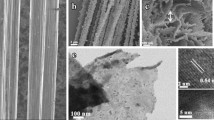Abstract
Platinum-modified carbon nanotube (CNT) fibers with controlled platinum weight percentages were synthesized via an electrochemical deposition method. Platinum nanoparticles can be uniformly deposited on the surface of the aligned CNTs in the fiber, which possesses an efficient improved catalytic activity in the reduction of I3 −/I− compared with other fiber materials such as a carbon fiber without the aligned nanostructure. The hybrid CNT fiber was further used as a counter electrode to fabricate fiber-shaped dye-sensitized solar cell (DSSC). A maximal power conversion efficiency of 8.10% was achieved, compared with that of 4.91% for a bare aligned CNT fiber and 5.50% for a platinum-modified carbon fiber as the counter electrode under the same condition.
摘要
本文利用电化学沉积法成功制备出铂纳米粒子修饰的取向碳纳米管纤维, 并对铂含量进行了有效调控. 铂纳米粒子均匀沉积于取向碳纳米管纤维表面, 与没有取向纳米结构的其他纤维材料(如碳纤维)相比, 更有效的提高了对I3 −/I−氧化还原反应的催化活性. 基于铂修饰的取向碳纳米管纤维作为对电极构建的纤维状染料敏化太阳能电池获得了高达8.10%的能量转换效率, 远高于基于取向碳纳米管纤维及铂修饰的碳纤维获得的4.91%和5.50%的能量转换效率.
Similar content being viewed by others
References
Dalton AB, Collins S, Munoz E, et al. Super-tough carbon-nanotube fibres. Nature, 2003, 423: 703–703
Ren J, Zhang Y, Bai W, et al. Elastic and wearable wire-shaped lithiumion battery with high electrochemical performance. Angew Chem Int Ed, 2014, 126: 7998–8003
Lee JA, Shin MK, Kim SH, et al. Ultrafast charge and discharge biscrolled yarn supercapacitors for textiles and microdevices. Nat Commun, 2013, 4: 1970
Wang K, Meng Q, Zhang Y, Wei Z, Miao M. High-performance two-ply yarn supercapacitors based on carbon nanotubes and polyaniline nanowire arrays. Adv Mater, 2013, 25: 1494–1498
Sun G, Zhou J, Yu F, et al. Electrochemical capacitive properties of CNT fibers spun from vertically aligned CNT arrays. J Solid State Electr, 2012, 16: 1775–1780
Sun G, Liu J, Zheng L, Huang W, Zhang H. Preparation of weavable, all-carbon fibers for non-volatile memory devices. Angew Chem Int Ed, 2013, 125: 13593–13597
Lin H, Weng W, Ren J, et al. Twisted aligned carbon nanotube/silicon composite fiber anode for flexible wire-shaped lithium-ion battery. Adv Mater, 2014, 26: 1217–1222
Chen T, Wang S, Yang Z, et al. Flexible, light-weight, ultrastrong, and semiconductive carbon nanotube fibers for a highly efficient solar cell. Angew Chem Int Ed, 2011, 50: 1815–1819
Chen T, Qiu L, Cai Z, et al. Intertwined aligned carbon nanotube fiber based dye-sensitized solar cells. Nano Lett, 2012, 12: 2568–2572
Chen T, Qiu LB, Kia HG, Yang ZB, Peng HS. Designing aligned inorganic nanotubes at the electrode interface: towards highly efficient photovoltaic wires. Adv Mater, 2012, 24: 4623–4628
Cai F, Chen T, Peng H. All carbon nanotube fiber electrode-based dye-sensitized photovoltaic wire. J Mater Chem, 2012, 22: 14856–14860
Zhang X, Li Q, Holesinger TG, et al. Ultrastrong, stiff, and lightweight carbon-nanotube fibers. Adv Mater, 2007, 19: 4198–4201
Li QW, Li Y, Zhang XF, et al. Structure-dependent electrical properties of carbon nanotube fibers. Adv Mater, 2007, 19: 3358–3363
Li QW, Zhang XF, DePaula RF, et al. Sustained growth of ultralong carbon nanotube arrays for fiber spinning. Adv Mater, 2006, 18: 3160–3163
Sun X, Chen T, Yang Z, Peng H. The alignment of carbon nanotubes: an effective route to extend their excellent properties to macroscopic scale. Acc Chem Res, 2012, 46: 539–549
Lima MD, Fang S, Lepró X. et al. Biscrolling nanotube sheets and functional guests into yarns. Science, 2011, 331: 51–55
Cui HF, Ye JS, Zhang WD, Wang J, Sheu FS. Electrocatalytic reduction of oxygen by a platinum nanoparticle/carbon nanotube composite electrode. JElectroanalChem, 2005, 577: 295–302
Yang Z, Sun H, Chen T. et al. Photovoltaic wire derived from a graphene composite fiber achieving an 8.45% energy conversion efficiency. Angew Chem Int Ed, 2013, 125: 7693–7696
Duarte M, Pilla A, Sieben J, Mayer C. Platinum particles electrodeposition on carbon substrates. Electrochem Commun, 2006, 8: 159–164
Sun H, You X, Deng J, et al. Novel graphene/carbon nanotube composite fibers for efficient wire-shaped miniature energy devices. Adv Mater, 2014, 26: 2868–2873
Gong F, Wang H, Xu X, Zhou G, Wang ZS. In situ growth of Co0.85Se and Ni0.85Se on conductive substrates as high-performance counter electrodes for dye-sensitized solar cells. J Am Chem Soc, 2012, 134: 10953–10958
Sun H, You X, Jiang YS, et al. Self-healable electrically conducting wires for wearable microelectronics. Angew Chem Int Ed, 2014, 53: 9526–9531
Peng HS, Sun XM, Cai FJ, et al. Electrochromatic carbon nanotube/polydiacetylene nanocomposite fibres. Nat Nanotech, 2009, 4: 738–741
Author information
Authors and Affiliations
Corresponding author
Additional information
YiShu Jiang is currently an undergraduate student majoring in chemistry at Fudan University since 2012. Her ressearch interest focuses on fiber-shaped devices for energy harvesting and storage.
HuiSheng Peng is currently a professor at the Department of Macromolecular Science and Laboratory of Advanced Materials at Fudan University. He received his BSc degree in Polymer Materials at Donghua University in China in 1999, MSc degree in Macromolecular Chemistry and Physics at Fudan University in China in 2003 and PhD in Chemical Engineering at Tulane University in USA in 2006. He then worked at Los Alamos National Laboratory before joining Fudan University in 2008. His research focuses on the development of miniature fiber-shaped solar cells, lithium ion batteries and supercapacitors. He has published more than 110 peer-reviewed papers.
Electronic supplementary material
Rights and permissions
About this article
Cite this article
Jiang, Y., Sun, H. & Peng, H. Synthesis and photovoltaic application of platinum-modified conducting aligned nanotube fiber. Sci. China Mater. 58, 289–293 (2015). https://doi.org/10.1007/s40843-015-0040-7
Received:
Accepted:
Published:
Issue Date:
DOI: https://doi.org/10.1007/s40843-015-0040-7




